
E-mail: font@focusonnature.com
Phone: Toll-free in USA 1-888-721-3555
or 302/529-1876
 |
PO
Box 9021, Wilmington, DE 19809, USA E-mail: font@focusonnature.com Phone: Toll-free in USA 1-888-721-3555 or 302/529-1876 |
A FOCUS ON NATURE
TOURS FEATURE
with updates Sept 2012 July 2012, July 2011, and July 2010
Some
Recent Bird Taxonomy Changes,
including two Murrelets where there was one
And new taxonomy from the BOU (the British Ornithologists Union)
and in a new book about owls
This feature, composed by Armas Hill, relates to
updates and revisions of bird taxonomy and nomenclature during the 3 years from
2012 back through 2010.
The changes
have been incorporated in the lists and photo galleries of birds linked at the
end of the feature.
September
2012:
In September 2012, the British Ornithologists Union
(the BOU) "split" the
Cory's Shearwater into
3 species:
- the Cory's Shearwater, Calonectris
borealis, breeding
on north Atlantic islands, in the Azores, Madeira, and
the Canary Islands, going, when not breeding, into the
western Atlantic Ocean
- the Scopoli's Shearwater, Calonectris
diomedea, breeding
in the Mediterranean Sea, going, when not breeding,
into the Atlantic Ocean
- the Cape Verde Shearwater, Calonectris edwardsii
(the last of these was already recognized by the American
Ornithologists Union, the AOU, in 2006)
In the field, the Scopoli's Sheawater can appear appreciably
smaller billed than the Cory's Shearwater.
However, it must be noted that both the Cory's Shearwater and
the Scopoli's Shearwater have marked sexual dimorphism, so
that a small female Cory's Shearwater can overlap in bill-size
with a male Scopoli's Shearwater.
But, because the Scopoli's Shearwater has a smaller head, its
bill can look large.
The Cory's Shearwater has been said to be the largest
shearwater. The wingspan of the Cory's Shearwater is from 113
to 124 cm. That of the Scopoli's Shearwater is from 110 to 121
cm.
Under similar conditions, the flight of the Scopoli's
Shearwater is lighter and less lumbering than that of the Cory's
Shearwater, with somewhat quicker wingbeats.
Off North America, the Scopoli's Shearwater is said to
occur as an uncommon to rare nonbreeding visitor, mostly from
May to October, in warmer waters from Florida north to New
England, and in the Gulf of Mexico.
It likely occurs in the North American range of the Cory's
Shearwater that is much more numerous.
Continuing with the recent taxonomic changes by the BOU, the
British Ornithologists Union:
This month, they "split" the Band-rumped Storm
Petrel into 3 species:
- the Madeiran Storm Petrel, Oceanodroma
castro, breeding in
the summer, from June to October, on the Madeira
archipelago and the northeastern Canary Islands
- the Cape Verde Storm Petrel, Oceanodroma
jabejabe, breeding
on the Cape Verde Islands, little known but said to
have 2 genetically distinct populations
- the Monteiros Storm Petrel, Oceanodroma
monteioroi, breeding
on the Azores Islands, described formally in 2008
From the recently-published book, "Petrels,
Albatrosses, & Storm-Petrels of North America, A
Photographic Guide", by Steve Howell, the following:
Recent studies have found considerable diversity within the Band-rumped
Storm Petrel complex, with at least 9 distinct
populations, with at least 5 in the Atlantic Ocean and 4 in
the Pacific Ocean.
Several, maybe all, of these populations are distinct enough
to be recognized as species. Identification at sea however can
still be described as problematic.
Another North Atlantic population, breeding in the winter,
that has been called the "Grant's Storm Petrel" has
yet to be described. It nests from October to March in the
eastern North Atlantic islands of the Azores,
Berlangas,
the Canary Islands, the Madeiran archipelago,
and the Selvagens.
The "Grant's Storm Petrel" has certainly been found
in oceanic waters offshore from eastern North America. The
wing molt schedule of most Gulf Stream and Gulf of Mexico
birds is consistent with the Grant's. It ranges at sea mainly from
May to August in warm waters of the western Atlantic and Gulf
of Mexico.
Other populations of what has been the Band-rumped Storm
Petrel may well occur off eastern North America
including the Madeiran Storm Petrel, which may be an
uncommon to rare non-breeding visitor to the Gulf Stream off
North Carolina and maybe elsewhere, probably from May to
August.
Other recent BOU taxonomic changes include:
The splitting of the Somali Courser, Cursorius
somalensis,
from the Cream-colored Courser, Cursorius
cursor.
We've seen the Cream-colored Courser (a nice bird!)
during FONT tours in the Canary Islands.
From the Arctic Warbler, Phylloscopus
borealis, that occurs in
Alaska, two splits:
1) the Kamchatka Leaf Warbler, Phyllopscopus
examinandus, and
2) the Japanese Leaf Warbler, Phyllopscopus xanthodryas
Both of these "new species" have been seen during
FONT tours in Japan.
In the area of the western Mediterranean, the Marmora's
Warbler has been split to:
1) the Balearic Warbler, Sylvia
balearica, on the Balearic
Islands, and
2) the Marmora's Warbler, Sylvia sarda, on
Corsica, Sardinia,
and in southern France
In the Eurasian Nuthatch there has been a "split".
With the new Siberian Nuthatch, Sitta
asiatica.
The Siberian Nuthatch has been seen numerous times during FONT
Japan Tours in Hokkaido.
The range of the Siberian Nuthatch is from the Ural
Mountains east to the Sea of Okhotsk, south to northern
Mongolia, northwestern Manchuria, and the northern Japanese island of Hokkaido.
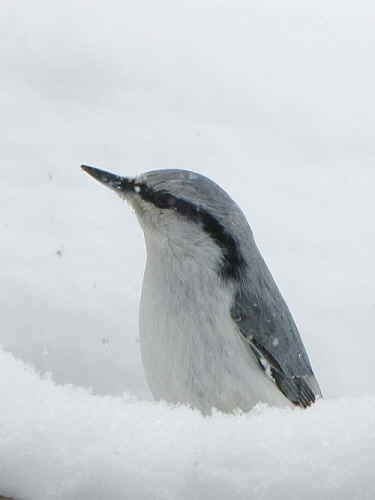
Siberian Nuthatch
A new subspecies has been created for the European Storm
Petrel, Hydrobates pelagicus.
It is: the Mediterranean Storm Petrel, Hydrobates
melitensis, breeding
on the Cabrera archipelago of the Balearic Islands off
northeastern Spain.
And, lastly, here, the BOU has put the
Ruff, the Buff-breasted Sandpiper, and the Broad-billed
Sandpiper into the genus Calidris.
These 3 species have had their own unique genera.
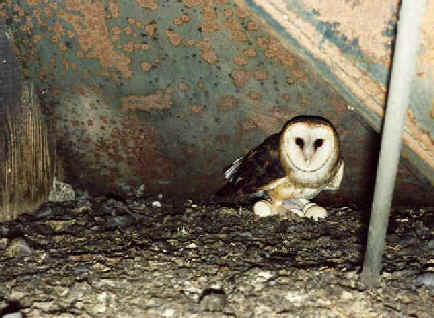
The American Barn Owl
ONE OF THE BEST BOOKS ANYWHERE ABOUT OWLS WAS PUBLISHED EARLIER THIS
YEAR, IN 2012.
It is entitled "Owls of the World, A Photographic
Guide", by Heimo Mikkola. In the book, the photographs
of virtually every OWL in the world, are tremendous,
and the text is informative and excellent.
Heimo Mikkola is an owl expert who has been studying
OWLS for a long time. Another book of his, "Owls of
Europe" has long been in my library. It was
published in 1983.
In the 2012 book, there is some interesting "new"
taxonomy, including:
the American Barn Owl split from that in the Old
World, along
with some other Barn Owls in the area of the Caribbean,
the splitting of owls in the Galapagos Islands, both the
Barn and the Short-eared Owls,
and the splitting of the Ferruginous Pygmy Owl into various
"species" including the Ridgway's Pygmy Owl
in
Central America, and the Chaco Pygmy Owl in, among other
places, southwestern Brazil.
A number of other adjustments have been made to screech
owls
and other pygmy owls in Central &
South America.
The Mottled Owl is treated as an exclusively South American
species, with now the Mexican Wood Owl in Mexico &
Central America.
In all, there are 249 different OWLS in the book.
![]()
July
2012:
"One Murrelet becomes Two, and what became of Caprimulgus?"
Now here's a name to try to say
quickly: "Scripps's Murrelet".
It's now the name of what was part of the Xantu's Murrelet. Now Mr. Xantu
only has a hummingbird for a namesake.
The Scripps's Murrelet, Synthliboramphus scrippsi,
occurs at sea in California. It ranges outside the breeding season north,
rarely, to northern California, and more rarely to Oregon and Washington State.
It breeds on islands off southern California: San Miguel, Santa Cruz, Anacapa,
Santa Barbara, San Clemente, and formerly Santa Catalina, and in western Baja
California, Mexico on San Benito, and Coronado and San Jeronimo islands. On
larger islands (such as San Miguel, Santa Cruz, and San Clemente), it is
confined largely or entirely to offshore rocks.
The other half of what was the Xantu's Murrelet is now the Guadalupe
Murrelet, Synthliboramphus hypoleucus.
It breeds on offshore rocks and islands off western Baja California, Mexico from
Guadalupe Island south to the San Benito islands. Breeding is unconfirmed on San
Martin Island, in Baja California, and San Clemente and Santa Barbara Islands in
California, USA.
It presumably winters offshore within the breeding range along the Pacific coast
of Baja California.
Other changes in the 53rd Supplement of the American Ornithologists' Union
Check-List of North American Birds, July 2012, include the following:
If you've been in Costa Rica and you've seen what have has been the Gray Hawk
in both the northern and the southern parts of the country, you can add a
species to your list.
From northern Costa Rica north to Arizona and Texas, and rarely New Mexico, it
is still the Gray Hawk, with the scientific name of Buteo
plagiatus.
From southern Costa Rica south into South America, it is now the Gray-lined
Hawk, Buteo nitidus.
South of Costa Rica, it is in Panama, Colombia, Venezuela, Trinidad &
Tobago, the Guianas. It is further south, west of the Andes to western Ecuador
and east of the Andes to Paraguay, northern Argentina, and southern Brazil.

An immature Gray Hawk
photographed during a FONT tour in Mexico
If you've been in Costa Rica, you may have another adjustment to your bird-list.
It is now the Costa Rican Brush Finch, Arremon
costaricensis, in southwestern Costa Rica and adjacent western Panama, and
the Black-headed Brush Finch, Arremon atricapillus,
further east in Panama. Both of these were part of the Stripe-headed Brush
Finch of further south, in South America, Arremon
torquatus.
If you've been to the Galapagos Islands, the Galapagos Shearwater, now Puffinus
subalaris, has been split from the Audubon's Shearwater. Genetics
have shown it to be more closely related to the Christmas Island Shearwater.
Other changes in 2012 relate to genera:
The genus of the Calliope Hummingbird is now Selasphorus,
the same genus as the Rufous, Allen's, and Broad-tailed Hummingbirds.
The Calliope was in a genus of its own, Stelluta.
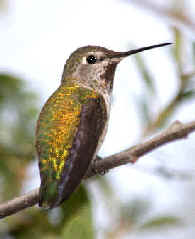
Calliope Hummingbird
Three North American finches are now in a new genus. The Purple, Cassin's, and House Finch are now Haemorhous. Previously they were in Carpodacus, an Old World genus containing the Common, or Scarlet, Rosefinch and other similar species.

House Finch, in North America, now in Haemorhous
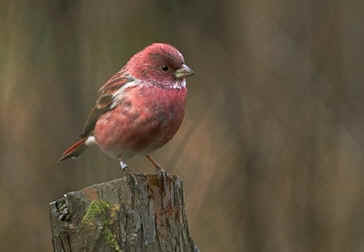
Pallas's Rosefinch, in Japan, still in Carpodacus
Some of us learned Caprimulgus
as the genus for the crepuscular and nocturnal birds known as "goatsuckers".
That Latin word, Caprimulgus, means "goat-milker".
Aristotle, among others, a long time ago, accepted the belief of shepherds that
the birds would fly to the udders of goats for their milk, and thus the name.
Of course, in reality, those birds, both in the Old World and the New World,
feed on flying insects.
Not due of nomenclature, but for anatomical reasons, Caprimulgus
is gone in the New World. The new genus of most of those birds is now Antrostomus,
and for some others, Hydropsalis.
Those in Antrostomas include: the Chuck-wills-widow,
the Eastern Whip-poor-will, the Mexican Whip-poor-will, and
the Buff-collared Nightjar.
Others in Mexico and Central and/or South America are: Rufous Nightjar, Tawny-collared
Nightjar, Yucatan Nightjar, and the Dusky Nightjar.
Those on Caribbean islands are the Greater Antillean Nightjar, and the
very rare & localized Puerto Rican Nightjar.
Birds formerly in Caprimulgus that are now in the
new genus Hydropsalis include: the White-tailed
Nightjar and the Spot-tailed Nightjar.
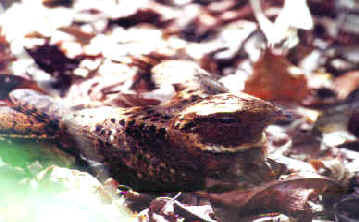
A Rufous Nightjar
during a FONT tour,
in the New World, now Antrostomas
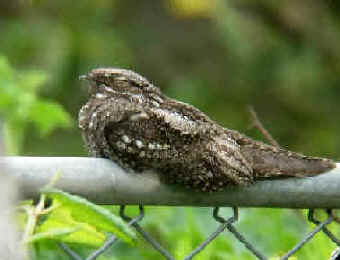
A Grey Nightjar during a FONT
tour,
in the Old World, still Caprimulgus
15 species of wrens, of Central & South America, and Mexico, are now
in new genera:
Now in Pheugopedius, these Wrens: Black-throated,
Black-bellied, Rufous-breasted, Spot-breasted, Sooty-headed, and Happy
(guessing it's "happy" now to be there).
Now in Thryophilus, these Wrens: Sinaloa (that's
the rarity that was found a couple years ago in southern Arizona), Rufus-and-white,
and Banded.
Now in Cantorchilus, these Wrens: Stripe-throated,
Stripe-breasted, Plain, Bay, Riverside, and Buff-breasted.
All of these wrens were in the now-defunct genus
Thryothorus.
Some raptors in Central and South America are now in different, or new, genera.
The Montane Solitary Eagle has been merged into Buteogallus, the genus of the
Black Hawks (the Common and the Great) and others.
For the Plumbeous Hawk, of Panama for example, one now has to type more letters
as Leucopternis plumbeus has become
Cryptoleucopteryx plumbeus.
Also exiting Leucopternis have been the White
Hawk, now Pseudastur albicollis, and the Barred
Hawk, now Morphnarchus princeps.
Cryptoleucopteryx, Pseudaster,
and Morphnarchus are all new genera, and each of
the 3 species just mentioned, the Plumbeous Hawk, the White Hawk,
and the Barred Hawk are the only members of their
genera.

White Hawk
The Central American Smoky-brown Woodpecker has been moved from the
Veniliornis genus to Picoides.
Also in the AOU 2012 Checklist, there is the first NEW bird species to have been
found in the United States in nearly four decades, 37 years.
But the bird was identified in a museum collection! It has been seen in life,
but not often.
The bird is the Byron's Shearwater, Puffinus byroni.
It was described in 2011, but from a specimen that had been collected in 1963 on
Midway Atoll, northwest of Hawaii in the Pacific Ocean.
At that time, that small shearwater was thought to be a Little Shearwater.
Later, a second specimen was tagged and recorded on Midway in 1990.
In February of 2012, DNA tests on 6 specimens of Puffinus
byroni, found on the Ogasawara Islands of Japan, alive and dead between
1997 and 2011, determined the birds to be Byron's Shearwaters.
It is assumed that the species still survives in the uninhabited Japanese
Ogasawara Islands.
![]()
July 2011 & July 2010:
"Once again a Gallinule, and Tanagers no longer so; also Wrens,
Whip-poor-wills, and more"
As of July 2011, according
the American Ornithologists Union (the AOU), it is the Common Gallinule throughout the
Americas, Gallinula galeata, distinct from the Common Moorhen,
Gallinula
chloropus, of the Old World.
After all, it is GALLINULA galeata!
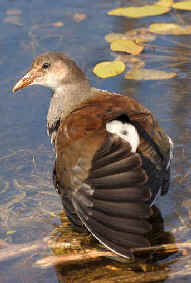
A juvenile Common Gallinule
(photo by Doris Potter)
And now the Snowy Plover
of the Americas, Charadrius nivosus, is distinct from the Kentish
Plover, Charadrius alexandrinus, of the Old World.
The Mexican Jay in the US has a new scientific name, Aphelocoma
wollweberi, as a portion of its population in Mexico has been split into a
new species, the Transvolcanic Jay, Aphelocoma ultramarina.
Further to the south, if you've seen the Chestnut-mandibled Toucan in
Costa Rica, you may be interested that it is now part of the more-southerly Black-mandibled Toucan,
Ramphastos
ambiguus.
If in the West Indies or northern South America, you've seen what has been
called the American Bare-eyed Thrush, it now has a new name, the Spectacled
Thrush. It is still Turdus nudigenis.
Among the Wood Warblers, throughout the Americas, there has been a major
taxonomic revision. In North America, no species have been "lost", and
none have been "gained", but there have been some notable changes as
to the genera.
"Parula" is still in the common English names for the Northern
and Tropical Parulas, but the genus is now gone.
What has been a large genus, Dendroica, is now gone.
The birds that have been in it, as well as the two Parulas, are now in
the genus where, until now, there has only been one bird, the American
Redstart. That now large genus is Setophaga.
The genus Wilsonia no longer exists. From it, the Hooded Warbler
is now in Setophaga, while the Canada Warbler and the Wilson's
Warbler are now in Cardellina, where previously there was only the Red-faced
Warbler that only reaches the US in Arizona.
Also now in the expanded Cardellina genus is the Red Warbler in
Mexico, and if you've never seen the dainty Pink-headed Warbler in
Guatemala, you might like to know that it is in Cardellina as well. The
Red and the Pink-headed Warblers were in
the
now defunct genus, Ergaticus.
The Connecticut Warbler is now the only member of the Oporornis
genus. The similar Mourning and MacGillivray's Warblers, along
with the Kentucky Warbler, have now gone to Geothlypis, the genus
of the Yellowthroats.
If you've seen the Barbuda Warbler or the Saint Lucia Warbler on
those respective Caribbean islands, or the Adelaide's or Elfin Woods
Warbler in Puerto Rico, or the Arrowhead Warbler in Jamaica, or the Vitelline
Warbler in the Cayman Islands, or the Plumbeous Warbler on
Dominica or Guadeloupe, they are all now in the genus Setophaga, rather
than Dendroica.
In Mexico and Guatemala, the Fan-tailed Warbler, formerly the
sole member of Euthlypis, is now in the genus Basileuterus, along
with, among others, the warbler that has the largest range of any in the
Americas, the Golden-crowned Warbler, that has also now been called the Stripe-crowned
Warbler.
In the Bahamas, there is now a new species. The Bahama Warbler,
Setophaga
flavescens, is now distinct from the Yellow-throated Warbler,
formerly Dendroica, now Setophaga dominica.
According to the July 2011 AOU List, the Yellow-breasted Chat is still a
"problematic" warbler, and the Mountain Chickadee
remains as it has been, one species.
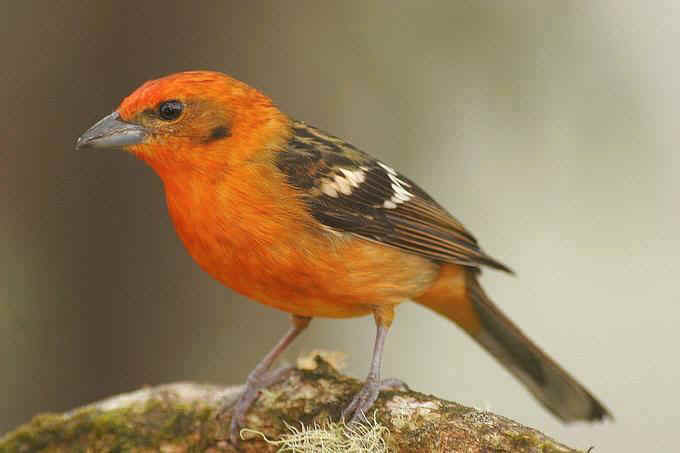
And now, the tanagers that are "no longer tanagers": The Flame-colored Tanager (above) and the Summer Tanager (below) and others in the genus Piranga are now in the Cardinal family (Cardinalidae), having left the family of Tanagers (Thraupidae) during the AOU changes in July 2010. More of the changes made in 2010 follow, including other tanagers moved to the family of cardinals.
(upper photo by Ruben Campos, lower photo by Howard Eskin)
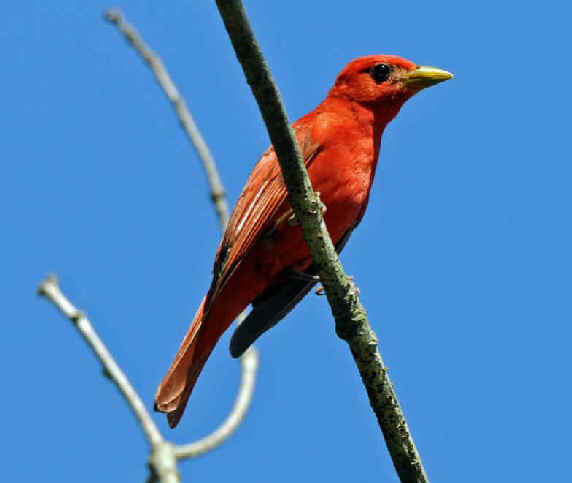
Usually, when people travel with
us on tours, they add "new birds to their list", seeing what they have
not seen previously.
Sometimes, however, such
"new birds" can be added later in the comfort, let's say, of an armchair
at home.
The new 51st Supplement of the
AOU (American Ornithologists Union) Bird Checklist came out in 2010, and among
the changes were these:
If you've seen what has been the
Winter Wren in parts of Alaska and elsewhere in western North America,
you can now mark it down as the Pacific Wren, Troglodytes
pacificus.
Pacificus, which was a subspecies of the
Winter Wren, was first described by Spencer Baird in 1864. There are 9
subspecies of the Pacific Wren, with a number of them restricted to
Alaskan islands in the Pacific.
The Winter Wren continues
in eastern North America, but now with the scientific name, Troglodytes
hiemalis.
What we've called the Winter
Wren in North America, has been "the Wren", in the Old
World, Troglodytes troglodytes. Now that bird is the Eurasian Wren.
It is the only wren outside the New World. In the Americas, there are about 75
species of wrens.
The Eurasian Wren,
however, has a range in places as far flung as Iceland, the Faroe Islands,
Japan, and Taiwan It has about 30
subspecies, and there may yet be more splits relating to it.
In eastern Asia, there are subspecies on the northern & southern Kuril
islands and the Commander Islands.
The subspecies on the Pribilof Islands of Alaska, T. t.
alascensis, described by Baird in 1869, may be of the Eurasian Wren.
The genus for at
least some of the Eurasian
Wren may
become Nannus,
from Troglodytes.
Some changes may yet happen with that widespread species, which has been in both the Old World & the New World,
beyond the changes that have been approved by the AOU.
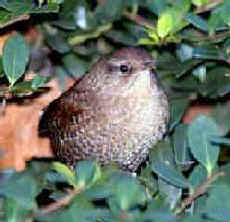
A Winter Wren
photographed in eastern North America
(photo by Howard Eskin)
If you've seen or heard a
whip-poor-will in the American Southwest, or in Mexico or Guatemala, you can now
mark it down as the Mexican Whip-poor-will, Caprimulgus arizonae,
distinct from the Eastern Whip-poor-will, Caprimulgus
vociferus, which breeds in eastern North America.
The Mexican Whip-poor-will is a bird of montane pine forests from the
southwest US to Honduras.
Also notable in the 2010 AOU adjustments, as noted above, is that what we have called "tanagers" in North America are no longer in the "tanager" family, Thraupidae. They were moved to the "cardinal" family, Cardinalidae.
In addition to the 4 species of
"tanagers" normally residing in North America, at least during part of the
year, some others in the Piranga genus in Central & South
America are also making the move. Their family ties notwithstanding, they are
all still keeping "tanager" as their common names.
The "real tanagers"
are now inhabitants of just Central & South America, and some Caribbean
islands.
Still to be called "Tanagers",
the birds in the genus Piranga, that are making the
move to the Cardinal family, Cardinalidae include the Scarlet,
Summer, Western, Hepatic, Tooth-billed (of southern Central America), Red
(of South America), Flame-colored, Rose-throated, White-winged, Red-headed,
and Red-hooded.
Others that made the move to Cardinalidae
are the ant-tanagers, in the genus Habia,
and those tanagers in the genus Chlorothraupis
(the Carimol's, Olive, Lemon-spectacled, and
Ochre-breasted).
Moving from Cardinalidae are the saltators,
in the genus Saltator, to a "place
unknown".
The following is from a narrative written in 2010 by Armas Hill, relating to the FONT Japan Tour in May of that year, and referring to yet more taxonomic changes. What is in burgundy print is from that narrative, and then, after that, more again relating to the 2010 AOU updates.
In the book, "Birds
of East Asia", by Mark Brazil,
some notable taxonomic "splits" of bird species include the following.
A number of these are also reflected in the 51st Supplement to the AOU
(American Ornithologists Union) Checklist.
Eastern Spot-billed Duck,
Anas zonorhyncha
from Spot-billed Duck,
Anas poecilorhyncha
Eastern Cattle Egret,
Bubulcus coromandus
from Western Cattle Egret,
Bubulcus ibis
Eastern Water Rail,
Rallus indicus
from Water Rail,
Rallus aquaticus
Eastern Buzzard,
Buteo japonicus
from Common Buzzard,
Buteo buteo
Eastern Black-tailed
Godwit,
Limosa melanuroides
from Black-tailed Godwit,
Limosa limosa
Eastern Grass Owl,
Tyto longimembris
from Grass Owl,
Tyto capensis
Eastern Great Tit,
Parus minor
from the now Northern
Great Tit,
Parus major
Eastern Yellow Wagtail,
Motacilla tschutschensis
from the Western Yellow
Wagtail,
Motacilla flava
Also:
Black-eared Kite,
Milvus lineatus
from Black Kite,
Milvus migrans
Northern Harrier,
Circus hudsonius
(of North America)
from Hen Harrier,
Circus cyaneus
Siberian Stonechat,
Saxicola maurus
from Eurasian Stonechat,
Saxicola torquatus.
For those of us in North America, it's notable that some of the birds just listed have occurred on our continent, especially in Alaska: the Eastern Spot-billed Duck, the Eastern Black-tailed Godwit, the more-regular Eastern Yellow Wagtail, and the Siberian Stonechat.

Eastern Spot-billed Ducks
photographed during a FONT tour in Japan
As to others having occurred in Alaska, I do not know but maybe the Eastern
Cattle Egret has.
Maybe someone else knows as to that.
Regarding the Eastern Cattle Egret, it is larger than the Western Cattle Egret, with a longer bill, neck and legs. The breeding plumage of the Western Cattle Egret is never as orange as that of the Eastern Cattle Egret. The legs of the Western Cattle Egret are yellowish or grayish-olive, and never black as those of the Eastern Cattle Egret can be.
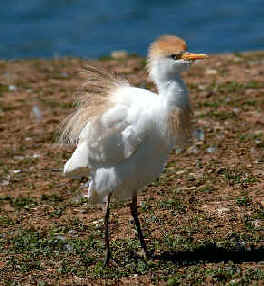
A Western Cattle Egret.
This species is believed to have come
to the Americas on its own from Africa.
(photo by Howard Eskin)
Also in the "Birds
of East Asia", by Mark Brazil,
the Black Scoter, Melanitta
americana,
is split from the Common
Scoter, Melanitta
nigra. It
is the Black Scoter
that occurs in North America, while the
Common Scoter
is in Europe. Along the Japanese coast in the winter, and breeding in Siberia,
it is the Black Scoter,
the otherwise "American bird".
Just as the terns
have recently been
placed into more genera, so have, in Brazil's book, the gulls:
Into Chroicocephas
from Larus:
Black-headed Gull,
Bonaparte's Gull.
Into Leucophaeus
from Larus:
Laughing Gull, Franklin's
Gull.
Into Hydrocoloeus
from Larus: Little
Gull.
The genus Chroicocephas
also applies now to the Gray-hooded Gull of South America & Africa.
and Leucophaeus applies
to the Gray Gull of South America.

Gray-hooded Gulls on a
beach,
photographed during a FONT tour in southern Brazil
(photo by Marie Gardner)
For another
species that has occurred on occasion in North America, mostly in Alaska, the
genus has been changed:
The Red-flanked Bluetail
is now in Luscinia
rather than Tarsiger.
The Luscinia
genus is also that of the Bluethroat
and the Siberian
Rubythroat.
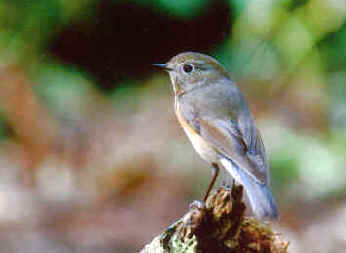
A Red-flanked Bluetail
photographed during a FONT tour in Japan
The 2 species of Jackdaws (the Western and the Daurian) are now in the genus Coloeus, instead of Corvus.
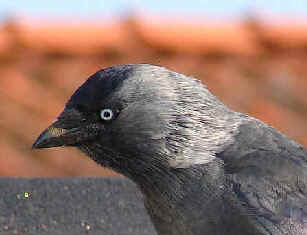
Western Jackdaw
(photo by Andy Ednie)
The Snow & McKay's Buntings are now in the genus Calcarius (with the Longspurs), instead of Plectrophenax.
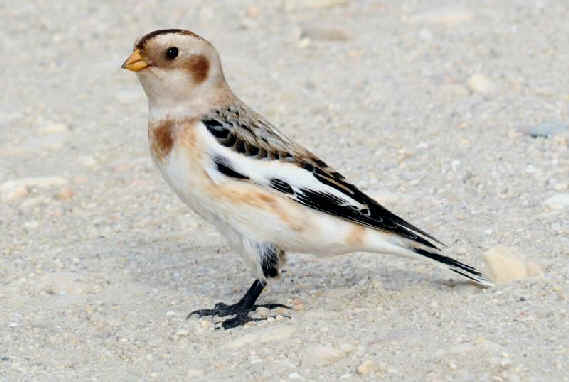
Snow Bunting
(photo by Howard Eskin)
The McCown's Longspur, of North America, now has its own genus, Rhynchophanes, as it is said to be more closely related to the Snow Bunting than to the other longspurs.
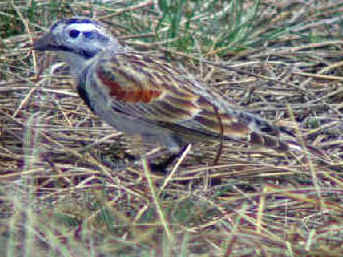
McCown's Longspur
The longspurs & the Snow Bunting now have a family of their own, the CALCARIIDAE, which is placed in proper order after the Olive Warbler and before the New World Warblers.
Among the New World Warblers, some now belong to a new genus, Oreothlypis. In it are: Tennessee, Orange-crowned, Nashville, Virginia's, Colima, Lucy's, and the Crescent-chested (of Mexico & northern Central America) and the Flame-throated (of southern central America).
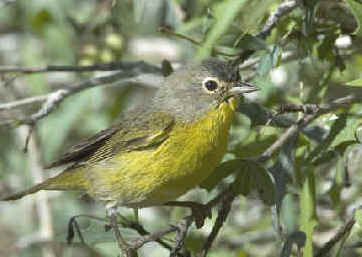
Nashville Warbler
The two waterthrushes are now in a genus of their own, Parkesia. And, so, now, the Ovenbird is the sole member of its genus, Seiurus.
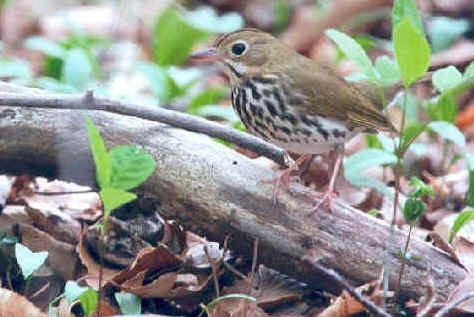
Ovenbird
(photo by Marie Gardner)
Some New World Sparrows are now in a new genus, but they remain in the
same family. Sparrows in the new genus Peucaea are:
Rufous-winged, Cassin's, Botteri's,
and Bachman's, along with these in Mexico and Central America: Cinnamon-tailed,
Black-chested, Bridled, and Stripe-headed.
The Five-striped Sparrow is now in the genus Amphispiza, along with the
Sage and
Black-throated Sparrows.
The Brown Jay now has its own genus, Psilorhinus.
It was, with others, in Cyanocorax.
The "brown towhees", the Canyon, California, Abert's,
and the White-throated of Mexico, have been transferred from the genus Pipilo
to Melozone, the genus of the ground sparrows
of Mexico and Central America.
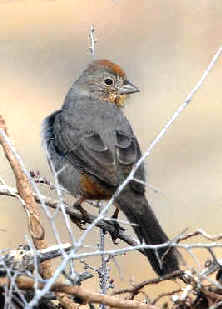
Canyon Towhee
(photo by Howard Eskin)
No longer in the genus Carduelis, the siskins and goldfinches are in the genus Spinus. Also from Carduelis, the redpolls are in the genus Acanthis, and the greenfinches, mostly in Eurasia, are in Chloris.
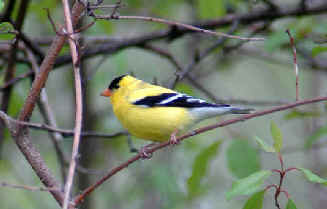
American Goldfinch
(photo by Howard Eskin)
Lastly, the AOU has now determined that Puffinus
gravis should now have the common name of Great Shearwater, as it has been
elsewhere. We've known it as the Greater Shearwater.
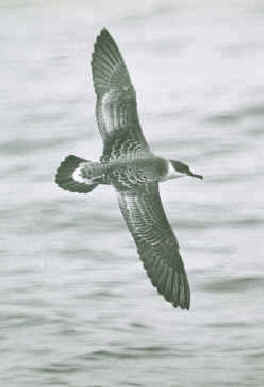
Great Shearwater
(photo by Alan Brady)
All of the changes that have been noted here, and some others, are now noted in the relevant bird-lists elsewhere in this web-site, for Asia, Europe, and North, Central, and South America, and the Caribbean. (Links follow)
Links to
Lists & Photo Galleries of Birds in the FONT Website:
BRAZIL:
Part #1: Tinamous to Doves
Part #2: Macaws to Flycatchers
Part #3:
Antshrikes to Grosbeaks
CARIBBEAN:
Part #1: Guineafowl to Hummingbirds
Part #2: Trogons to Buntings
CENTRAL AMERICA: Part #1: Tinamous to Doves Part #2: Macaws to Woodpeckers
Part #3: Manakins to Thrushes Part #4: Thrushes to Buntings
EUROPE: Part #1: Grouse to Puffin Part #2: Sandgrouse to Buntings
JAPAN: Part #1: Pheasants to Pittas Part #2: Minivets to Buntings
MEXICO: Part #1: Tinamous to Shorebirds Part #2: Jaegers to Flycatchers
NORTH AMERICA: Part #1: Grouse to Anhinga Part #2: Condor to Shorebirds
Part #3: Jaegers to Flycatchers Part #4: Owls to Flycatchers
Part
#5: Shrikes to Pipits Part #6: Olive Warbler to Buntings
Other Links:
Upcoming FONT Birding & Nature Tours
FONT Past Tour Highlights
![]()